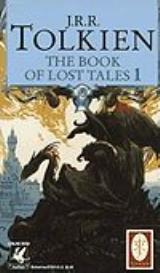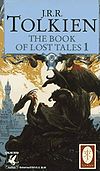
The Book of Lost Tales
Encyclopedia

The Book of Lost Tales is the title of a collection of early stories by J. R. R. Tolkien
J. R. R. Tolkien
John Ronald Reuel Tolkien, CBE was an English writer, poet, philologist, and university professor, best known as the author of the classic high fantasy works The Hobbit, The Lord of the Rings, and The Silmarillion.Tolkien was Rawlinson and Bosworth Professor of Anglo-Saxon at Pembroke College,...
, and of the first two volumes of Christopher Tolkien
Christopher Tolkien
Christopher Reuel Tolkien is the third and youngest son of the author J. R. R. Tolkien , and is best known as the editor of much of his father's posthumously published work. He drew the original maps for his father's The Lord of the Rings, which he signed C. J. R. T. The J...
's 12-volume series The History of Middle-earth
The History of Middle-earth
The History of Middle-earth is a 12-volume series of books published from 1983 through to 1996 that collect and analyse material relating to the fiction of J. R. R. Tolkien, compiled and edited by his son, Christopher Tolkien. Some of the content consists of earlier versions of already published...
, in which he presents and analyses the manuscripts of those stories, which were the earliest form of the complex fiction
Fiction
Fiction is the form of any narrative or informative work that deals, in part or in whole, with information or events that are not factual, but rather, imaginary—that is, invented by the author. Although fiction describes a major branch of literary work, it may also refer to theatrical,...
al myth
Mythology
The term mythology can refer either to the study of myths, or to a body or collection of myths. As examples, comparative mythology is the study of connections between myths from different cultures, whereas Greek mythology is the body of myths from ancient Greece...
s that would eventually comprise The Silmarillion
The Silmarillion
The Silmarillion is a collection of J. R. R. Tolkien's mythopoeic works, edited and published posthumously by his son Christopher Tolkien in 1977, with assistance from Guy Gavriel Kay, who later became a noted fantasy writer. The Silmarillion, along with J. R. R...
. Each of the Tales is followed by notes and a detailed commentary by Christopher Tolkien.
Though they cover a broadly similar history, the Tales are very different from The Silmarillion. Firstly the Tales are more complex and detailed, written in an archaic style and include many obsolete words and phrases. Secondly, the interaction between the different elf-races is profoundly different from the Silmarillion: The exiled Noldoli (or "Gnomes", the Noldor
Noldor
In the works of J. R. R. Tolkien, the Noldor are Elves of the Second Clan who migrated to Valinor and lived in Eldamar. The Noldor are called Golodhrim or Gódhellim in Sindarin, and Goldoi by Teleri of Tol Eressëa. The singular form of the Quenya noun is Noldo and the adjective is Noldorin...
of the later histories) suffer decisive defeat much earlier and become slaves of the enemy they had sought to punish. When Thingol
Thingol
Elu Thingol is a fictional character in J.R.R. Tolkien's Middle-earth legendarium. He appears in The Silmarillion, The Lays of Beleriand and Children of Húrin as well as in numerous stories in the many volumes of The History of Middle-earth...
feels disdain for Beren
Beren
Beren is a fictional character in J. R. R. Tolkien's Middle-earth legendarium. He appears in The Silmarillion. Huan spoke to him.-Character overview:...
, it is because the latter is a gnome (not a mortal human) and therefore a thrall of Melko.
While many of the names in the book are identical or close to those in the later versions, some of them bear almost no resemblance to their final forms. J. R. R. Tolkien changed names rather frequently, sometimes with several new variants (rejected in turn) written in a single manuscript. Confusingly, sometimes the name applied to one thing is later used to refer to a different thing, the original use abandoned. As an example, the house of Elves
Elf (Middle-earth)
In J. R. R. Tolkien's legendarium, Elves are one of the races that inhabit a fictional Earth, often called Middle-earth, and set in the remote past. They appear in The Hobbit and in The Lord of the Rings, but their complex history is described more fully in The Silmarillion...
called "Teleri" in The Book of Lost Tales is not the same as that in The Silmarillion (see Teleri
Teleri
In the works of J. R. R. Tolkien, the Teleri, Those who come last in Quenya were the third of the Elf clans who came to Aman...
). The original usage of "Teleri" would eventually change until the name became "Vanyar
Vanyar
In the works of J. R. R. Tolkien, the Vanyar are the fairest and most noble of the High Elves. They are the smallest of the three clans of the Eldar, and were the first to arrive in Aman. According to legend, the clan was founded by Imin, the first Elf to awake at Cuiviénen, his wife Iminyë, and...
". Meanwhile, the house of Elves called "Solosimpi" would inherit the name "Teleri".
The framework for the book is that a mortal Man visits the Isle of Tol Eressëa
Tol Eressëa
In early versions of J. R. R. Tolkien's legendarium , Tol Eressëa was an island visited by the Anglo-Saxon traveller Ælfwine which provided a framework for the tales that later became The Silmarillion. The name is the Elvish for "Lonely Island"...
where the Elves live. In the earlier versions of the "Lost Tales" this man is named Eriol, of some vague north European origin, but in later versions he becomes Ælfwine, an Englishman of the Middle-ages.
There are more changes visible within the book, and it is not internally consistent, partially because even while still writing it Tolkien began rewriting earlier parts as his ideas about the world changed. The Tales were eventually abandoned, but they were resurrected in part as the "Sketch of the Mythology
The Shaping of Middle-earth
The Shaping of Middle-earth is the fourth volume of Christopher Tolkien's 12-volume series The History of Middle-earth in which he analyses the unpublished manuscripts of his father J. R. R...
" which would become the Silmarillion.
For publication the book was split into two volumes: The Book of Lost Tales 1 (1983) and The Book of Lost Tales 2 (1984), but this is simply an editorial division. Both volumes are separated into several "Lost Tales".
Contents of Book 1
- "The Cottage of Lost Play" — the "framework" story
- "The Music of the Ainur" — the first version of what would become the AinulindalëAinulindalëThe Ainulindalë is the first part of the fantasy work The Silmarillion by J. R. R. Tolkien. In Tolkien's legendarium, the Ainur are Eä's divine beings. In Heaven, before Time, they compose a Great Music. This Music is revealed to be the template, or blueprint, commensurable with the entire history...
- "The Coming of the ValarVala (Middle-earth)The Valar are fictional characters in J. R. R. Tolkien's legendarium. They are first mentioned in The Lord of the Rings, but The Silmarillion develops them into the Powers of Arda or the Powers of the World...
and the Building of ValinorValinorValinor is a fictional location in J. R. R. Tolkien's legendarium, the realm of the Valar in Aman. It was also known as the Undying Lands, along with Tol Eressëa and the outliers of Aman. This is something of a misnomer; only immortal beings were allowed to reside there, but the land itself,...
" — later ValaquentaValaquentaValaquenta is the second section of The Silmarillion, a collection of J. R. R. Tolkien's mythopoeic works, edited and published posthumously by his son Christopher Tolkien in 1977.-Overview:...
and first chapters of Quenta SilmarillionQuenta SilmarillionQuenta Silmarillion is a collection of fictional legends written by the high fantasy writer J. R. R. Tolkien. It was published after the author's death in The Silmarillion together with four shorter stories... - "The Chaining of Melko" — Melko is an earlier name of MelkorMorgothMorgoth Bauglir is a fictional character from J. R. R. Tolkien’s Middle-earth legendarium. He is the main antagonist of The Silmarillion, figures in The Children of Húrin, and is mentioned briefly in The Lord of the Rings.Melkor was the most powerful of the Ainur, but turned to darkness and became...
- "The Coming of the Elves and the Making of Kôr" — Kôr is the later TirionTirionIn J. R. R. Tolkien's legendarium, Tirion upon Túna was the city of the Noldor in Valinor...
and its hill Túna - "The Theft of Melko and the Darkening of Valinor"
- "The Flight of the Noldoli" — "Noldoli" are the Elves later called NoldorNoldorIn the works of J. R. R. Tolkien, the Noldor are Elves of the Second Clan who migrated to Valinor and lived in Eldamar. The Noldor are called Golodhrim or Gódhellim in Sindarin, and Goldoi by Teleri of Tol Eressëa. The singular form of the Quenya noun is Noldo and the adjective is Noldorin...
- "The Tale of the Sun and Moon"
- "The Hiding of Valinor"
- "Gilfanon's Tale: The Travail of the Noldoli and the Coming of Mankind"
Contents of Book 2
- "The Tale of Tinúviel" — first version of the tale of BerenBerenBeren is a fictional character in J. R. R. Tolkien's Middle-earth legendarium. He appears in The Silmarillion. Huan spoke to him.-Character overview:...
and LúthienLúthienLúthien Tinúviel is a fictional character in the fantasy-world Middle-earth of the English author J. R. R. Tolkien. She appears in The Silmarillion, the epic poem The Lay of Leithian, The Lord of the Rings and the Grey Annals, as well as in other material.-Character overview:Lúthien is a Telerin ... - "Turambar and the Foalókë" — first version of the TúrinTurínTurín is a municipality in the Ahuachapán department of El Salvador....
saga - "The Fall of Gondolin" — the only full narrative of the Fall of Gondolin
- "The Nauglafring" — a story which was "lost", in that it never was rewritten in full, and was mostly left out of the later Silmarillion.
- "The Tale of Eärendel" — the only full narrative of EärendilEärendilEärendil the Mariner is a fictional character in J. R. R. Tolkien's Middle-earth legendarium. He is depicted in The Silmarillion as a great seafarer who, on his brow, carried the morning star across the sky.-Etymology:...
's travels - "The History of Eriol or Ælfwine and the End of the Tales" — an essay about the changes in the framework, and the "unwritten" tales.
There is an inscription in the Fëanorian characters (Tengwar
Tengwar
The Tengwar are an artificial script created by J. R. R. Tolkien. In his fictional universe of Middle-earth, the tengwar were invented by the Elf Fëanor, and used first to write the Elven tongues: Quenya, Telerin, and also Valarin. Later a great number of languages of Middle-earth were written...
, an alphabet Tolkien has devised for High-Elves) in the first pages of every History of Middle-earth volume, written by Christopher Tolkien and describing the contents of the book.
The inscription in Book I reads: "This is the first part of the Book of the Lost Tales of Elfinesse which Eriol the Mariner learned from the Elves of Tol Eressëa, the Lonely Isle in the western ocean, and afterwards wrote in the Golden Book of Tavrobel. Herein are told the Tales of Valinor, from the Music of the Ainur to the Exile of the Noldoli and the Hiding of Valinor.".
The inscription in Book II reads: "This is the second part of the Book of the Lost Tales of Elfinesse which Eriol the Mariner learned from the Elves of Tol Eressëa, the Lonely Isle in the western ocean, and afterwards wrote in the Golden Book of Tavrobel. Herein are told the Tales of Beren and Tinúviel, of the Fall of Gondolin and the Necklace of the Dwarves.".

